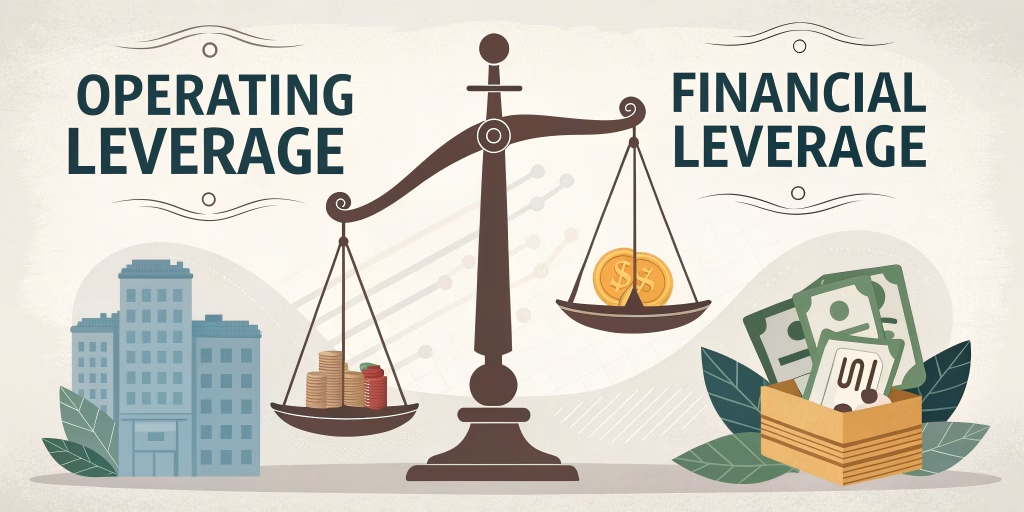Running a business means using tools that help you grow and manage risk. Two of the most powerful tools are operating leverage and financial leverage. They both boost your profits, but in different ways. This guide will explain what each one is, how they work, and how to use them wisely. By the end, you’ll know how to apply these ideas to help your business succeed.
What Is Leverage?
Leverage means doing more with less. In business, that means using resources to make more profit. You can use operating leverage or financial leverage. Both types help you grow, but each one works in its own way.
- Operating leverage uses fixed costs to make profits grow faster when sales go up.
- Financial leverage uses borrowed money to try to earn more for business owners.
Think of leverage like riding a bike. You pedal to move forward. Gears help you climb hills. Both pedals and gears make your ride easier. In business, operating and financial leverage make growth easier.
Simple Definitions
- Leverage: Using resources to make more money.
- Operating leverage: Using fixed costs (like rent) to boost profit when sales rise.
- Financial leverage: Using loans to try to increase profit for owners.
What Is Operating Leverage?
Operating leverage shows how your fixed costs affect profit when sales change. Fixed costs are expenses you pay no matter how much you sell. Examples include rent, salaries, and insurance.
When you have high operating leverage, a small rise in sales can lead to a big rise in profit. That is because fixed costs stay the same as you sell more. But if sales drop, profit falls fast because you still pay the same fixed costs.
A Simple Bakery Example
Imagine you run a small bakery. Every month, you pay $1,000 rent and $500 utilities. You bake 100 cakes, so your fixed cost per cake is low. If you sell 100 cakes at $10 each, your revenue is $1,000. After paying $1,500 in fixed costs, you have no profit. But if you sell 200 cakes, your revenue is $2,000. You still pay $1,500 in fixed costs, so you make $500 profit. That extra $500 mostly goes to profit because fixed costs did not rise.
- Fixed cost per cake at 100 cakes = $1,500 ÷ 100 = $15
- Fixed cost per cake at 200 cakes = $1,500 ÷ 200 = $7.50
This shows how profit grows when sales rise with fixed costs.
Key Points About Operating Leverage
- Profit boost: Sales up → profit up fast.
- Risk in slow times: Sales down → profit down fast.
- Common in services: Software firms have high operating leverage. They spend a lot on servers and staff, but each extra sale costs little.
What Is Financial Leverage?
Financial leverage uses loans to fund business activities. When you borrow, you expect your investment returns to beat your loan cost. Loans can help you grow faster. But they also add risk. You must pay back the loan with interest, no matter how your business does.
A Simple Restaurant Example
You want to open a small restaurant but lack cash. You borrow $50,000 and pay $5,000 a year in loan interest. If your restaurant earns $20,000 profit, you keep $15,000 after interest. But if you earn only $3,000 profit, you still pay $5,000 interest, leaving you $2,000 in loss.
- Profit before interest = $20,000
- Interest cost = $5,000
- Profit after interest = $15,000
If your return on investment beats the interest, you earn more. If not, you lose.
Key Points About Financial Leverage
- Return boost: Good years → higher profit after interest.
- Higher risk: Bad years → interest still due → losses.
- Use with care: Over-borrowing can lead to insolvency.
Comparing Operating and Financial Leverage
Both tools amplify profit, but they work on different resources. Here is a simple table:
| Aspect | Operating Leverage | Financial Leverage |
| Main resource | Fixed operating costs | Borrowed funds (loans) |
| Profit impact | Sales up → profit up fast | Good returns → profit up fast |
| Risk | Sales down → profit down fast | Bad returns → high losses |
| Control | Set by management costs & price | Set by loan terms & interest |
Calculating Leverage
Operating Leverage Formula
Degree of Operating Leverage (DOL) =
%Change in EBIT%Change in Sales
This shows how a change in sales affects operating income.
Financial Leverage Formula
Degree of Financial Leverage (DFL) =
%Change in EPS%Change in EBIT
This shows how a change in operating income affects earnings per share.
Risks of Each Type
Using leverage increases both gains and losses. You must manage risks.
Risks in Operating Leverage
- Sales swings: Profits swing more with sales changes.
- High fixed costs: Pay even when sales fall.
- Low flexibility: Hard to cut fixed costs quickly.
Risks in Financial Leverage
- Debt burden: Must pay interest and principal on time.
- Interest changes: Rates can rise, raising costs.
- Insolvency: Too much debt can bankrupt you.
Role of Costs
Fixed vs. Variable Costs
- Fixed costs: Stay the same (rent, salaries).
- Variable costs: Change with production (materials, hourly pay).
High fixed costs and low variable costs = high operating leverage.
How Leverage Affects Profitability
- Operating leverage: More sales → bigger profit jump. Fewer sales → bigger profit drop.
- Financial leverage: Good returns → extra profit. Bad returns → heavy losses.
Benefits of Leverage
- Amplified returns: Earn more money when things go well.
- Growth speed: Expand faster with less cash.
- Strategic moves: Fund big projects and enter new markets.
Drawbacks of Leverage
- Higher risk: Losses grow when things go wrong.
- Cash drain: Loan payments and fixed costs still due.
- Market sensitivity: Leverage makes you more exposed to downturns.
Real-World Examples
- Tech startups: Borrow to fund research. If their product wins, returns beat loan costs. If not, debt sinks them.
- Manufacturing plants: High fixed costs for machines. They need high sales to cover those costs. Sales drop → big profit loss.
How to Manage Leverage
- Balance costs: Keep fixed and variable costs in check.
- Limit debt: Borrow only what you need.
- Plan for slow times: Have cash reserves or flexible costs.
- Watch interest: Lock in low rates when possible.
Final Thoughts
Leverage is a tool, not a magic fix. Operating and financial leverage can help your business grow faster and earn more. But they also add risk. The key is to use just the right amount. Keep costs in check, borrow wisely, and plan for ups and downs. That way, you can ride the leverage “gears” to success without crashing on the hills.
Happy learning, and here’s to smart business growth!
Frequently Asked Questions
Q: Which leverage is safer?
A: Neither is risk-free. Operating leverage is safer if sales are stable. Financial leverage is safer if you get low-rate loans and have steady cash flow.
Q: Can a company use both?
A: Yes. Most firms use both. They balance fixed costs and debt to fit their strategy.
Q: How much leverage is too much?
A: It depends on your industry and market. Watch your debt-to-equity ratio and profit swings. If profits drop too much in slow times, you may be over-leveraged.





